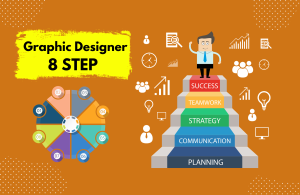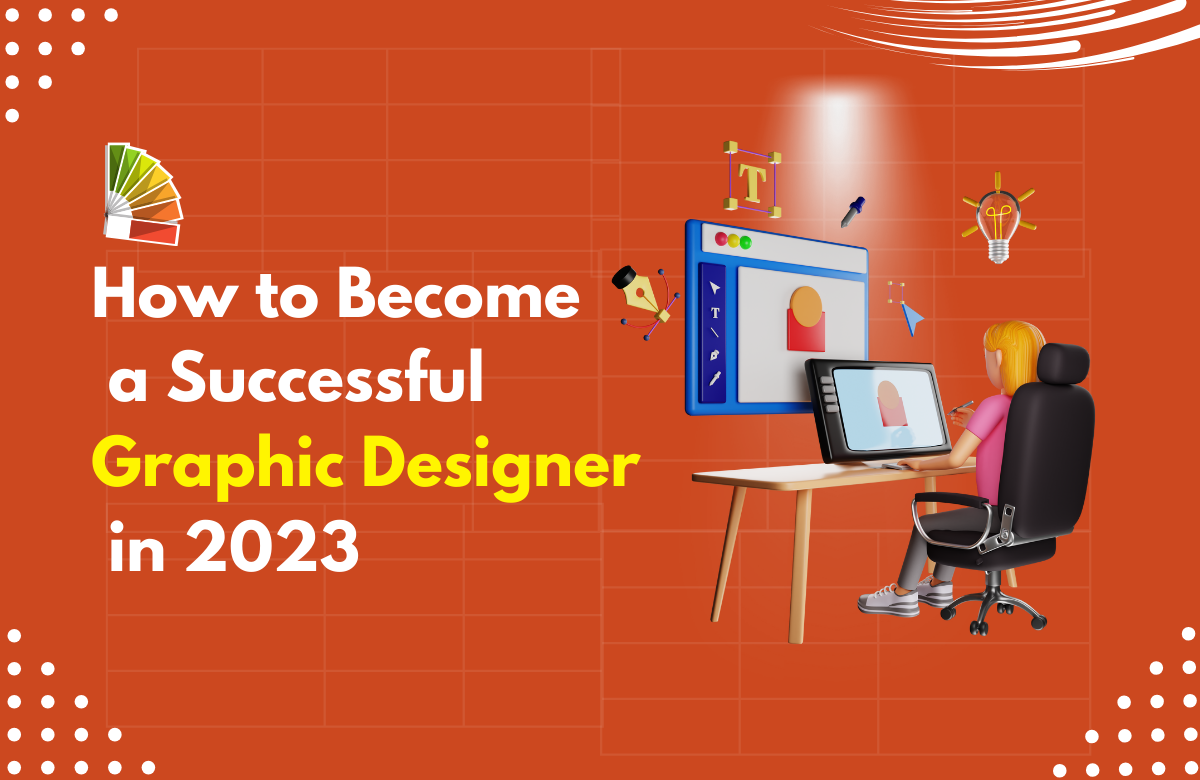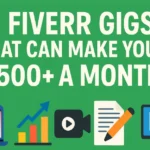Starting a career as a graphic designer is a dream many of us have. It’s about the realization of bringing different ideas to life in fresh and unique ways. This journey begins with a single step, often from scratch. Over the years, you learn different things and discover new ways. A well-structured course can teach you the necessary steps towards achieving this goal. Stay open to learning and keep your passion for design alive.
Is It Easy To Become a Graphic Designer?
In the creative industry, a graphic designer can become successful by mastering various aspects of art and design. A strong understanding of visual communication is crucial, including areas such as print design and motion graphics. For success in 2023, it’s vital to stay updated with industry trends and constantly enhance your learning materials.
Building a strong portfolio is another key step towards becoming a successful graphic designer. This should showcase your best work in a professional environment. Furthermore, networking within the design community, seeking constructive feedback, and developing a personal brand are essential. Embrace continuous learning to stay relevant and competitive in the dynamic field of graphic design.
Table of Contents
ToggleWhat Does a Graphic Designer Do?
Visual communicators, also known as graphic designers, play a crucial role in the design industry. They are responsible for creating visual elements like branding, adverts, apps, magazines, packaging, logos, books, maps, and websites on a daily basis. These professionals break down a client’s brief to transform an idea or concept into something visual, transcending stereotypes and clichés. They indeed come from all walks of life, underscoring that anyone can excel in graphic design.
What Are Different Types of Graphic Designers?
Graphic designers are creative artists who use visuals to communicate messages. Different types include brand identity designers, web designers, print designers, and motion graphics designers, each crafting unique pieces across various mediums.
In-House Graphic Designers
Employed by a company, In-House Graphic Designers cater to various needs and tasks, such as designing marketing campaigns or compiling annual reports. They may operate within a creative team or as a solo designer, depending on the size of the creative department, enjoying the stability of a traditional work environment, steady paychecks, and a regular work schedule.
With an in-depth understanding of the company’s style and audience, these designers effectively build the brand through long-term design ideas and strategies. Their role involves continual improvement of their previous work, ensuring the established brand is consistently represented across all platforms.
Agency Graphic Designers
Clients and agencies frequently hired Graphic Designers for short-term projects or specific campaigns. Their needs often vary, catering to the demands of handling several brands, making it a fast-paced environment. Every brand has high expectations for stellar design, providing an opportunity for both new and established Designers who are eager to learn and grow. Working alongside colleagues, they gain a first-hand look at different design processes. This experience not only proves useful for new Designers keen on learning but also allows established Designers to enhance their specialization and expertise.
Freelance Graphic Designers
Freelance Graphic Designers are self-employed, juggling between managing clients, handling invoices, and working on a variety of projects. Being self-motivated and business-savvy, they enjoy the flexibility to live and work according to their own schedule. From the beginning, they are selective in building their client base, balancing marketing and administrative tasks. They constantly seek out opportunities, competing for pay based on the type and amount of work, making each day an inspiring journey.
Is Graphic Design a Growing Field?
The U.S. Bureau of Labor Statistics foresees a decline in the employment of Graphic Designers in the print industry by 2029, specifically within newspapers, periodicals, book and directory publishers. Yet, it anticipates growth in digital design sectors. Advancements in website design, animation, mobile application design, multimedia, and virtual design are increasing opportunities for Graphic Designers. Specialization in high demand fields of design like UI and UX design could offer a positive career outlook in this shifting landscape of the graphic design industry..
How To Become A Graphic Designer in 8 Steps

Become a graphic designer in eight steps, start by developing your skills and studying the field. Next, gain practical experience through internships or freelance work, and build a strong portfolio. Then, market yourself through networking and social media. Finally, always stay current by continuing your education and learning new design techniques.
Step 1: Be Creative
Taking the first step into a career as a graphic designer is relatively easy, but improving your chances of becoming successful requires bucket loads of creativity. Whether you were born with a creative streak or developed it as you grew older, it’s a key aspect to finding success in this field. Rest assured, no matter how many years it takes, once you have found and nurtured your creativity, professional success can be achieved.
Step 2: Become a Problem Solver
As a graphic designer, it’s essential to be creative and naturally inclined to solve problems. This career demands that thinking outside the box becomes second nature. From interpreting client briefs to brainstorming potential solutions, the practice involves constantly generating new ideas and putting them to paper. In your day-to-day life, this might be akin to how you plan your cooking or shopping; it’s about understanding the ingredients needed to provide the best service and tackle problems head-on.
It’s similar to any graphic design scenario where the solution is drawn from thorough understanding of the problems, through continuous practice to solve them. The role of a graphic designer thus extends beyond just designing – it includes understanding client briefs, offering appropriate service, fostering brainstorming sessions, envisioning potential solutions, curating ideas, and materializing them on paper.
Step 3: Learn the Important Graphic Design Tools
In the design world, mastering the Adobe Suite is paramount for any aspiring graphic designer. Proficiency in Photoshop, Illustrator, and InDesign is crucial, even at an intermediate skill level. At Shillington, both full-time and part-time students immerse themselves in industry-standard design software, receiving hands-on training in Adobe Suite, InDesign, Illustrator, and even digital prototyping apps like Sigma.
Through software demonstrations and one-on-one technical guidance from experienced teachers, students start from square one, learning best practices, tips, and shortcuts to tackle real-world briefs.
For those venturing into a new career in digital design, familiarity with tools like Fatma is key. Collaborating to create and prototype digital ideas becomes seamless using these digital design apps. At workplaces, staying connected through platforms like Slack and Zoom is crucial for graphic designers to work productively. Ensuring these programs are efficiently downloaded and set up on the computer becomes foundational to the workflow.
Step 4: Enroll in a Graphic Design Course
As an interested graphic designer, it’s crucial to learn the right tools and programs. Don’t fall into the trap of relying solely on your innate creativity; instead, equip yourself with the necessary gear like a pen and sketchbook. Many successful self-taught designers have honed their skills by practicing on online forums and watching tutorials on YouTube. Personally, I think this hands-on approach is the best way to become a proficient graphic designer.
When it comes to the best way of becoming a graphic designer, taking a course is often the most effective option. With several choices available, Shillington’s innovative graphic designer course stands out. Whether you opt for the three-month full-time or nine-month part-time program, the convenience of learning from your own sofa is unmatched.
At Shillington, you’ll learn to use essential Adobe software like InDesign, Photoshop, Illustrator, and Sketch. The comprehensive curriculum covers both theoretical knowledge and practical skills, ensuring that graduates leave well-prepared to embark on a new career in graphic design.
Step 5: Understand the Fundamentals
Certainly, here’s a concise guide to mastering the fundamentals of graphic design through the Shillington course. To effectively teach design, emphasize graphic design principles such as alignment, repetition, contrast, hierarchy, and balance. These principles are essential for creating successful and visually appealing designs that are properly structured.
For any aspiring graphic designer, a quick guide to success involves mastering the fundamentals of design: alignment, repetition, contrast, hierarchy, and balance. By doing so, you can ensure your designs are visually appealing and properly structured, creating a foundation for success in the field.
A graphic designer worth their salt understands the importance of practice in stress-testing designs. To create visually appealing and properly structured designs, focus on the key elements of alignment, repetition, contrast, hierarchy, and balance. These elements are crucial for sharpening your skills and achieving a unified design.
Understanding alignment is vital for a sharper and more unified design. Repetition strengthens the design by tying together separate parts and forming associations. Contrast is effective in creating emphasis and impact. Hierarchy is essential for organizing elements, and balance provides stability and structure, ensuring symmetry and managing tension between elements.
Step 6: Be a Bookworm
Looking to get ahead as a graphic designer? Obviously, there are many options out there, but when it comes to recommendations for amazing graphic design books, there’s a good book for every sort. To help sort the wheat from the chaff, a great way to start is with the latest and the classics. For the essentials, delve into Design History with Jen Muller’s incredible two-volume set:
History of Graphic Design Volume 1 and Volume 2. The first covers the years 1890-1959, while the second takes you from 1960 right now. Understanding the history of the field is essential for any working graphic designer who wants to get a good head from scratch.
One of my childhood favorites in the realm of graphic design isn’t a novel, but rather a dive into typography. There are a lot of books dedicated to this, and two favorites are Why Fonts Matter by Sarah Hyndman and The Visual History of Type by Paul McNeil. Hyndman’s book clearly explains how fonts influence and evoke specific experiences, while McNeil’s offers a comprehensive survey of major typefaces produced since printing’s advent.
For design inspiration, worth opening up are titles like DESIGN(H)ERS, celebrating women in design, and the British Rail Corporate Identity Manual—both brilliant in their own way. The former covers a wide range of backgrounds and crafts from an all-women team, while the latter, a classic case study, is a superb source of guidance for modern-day designers. These different books, while diverse, offer a superb taste of what the journey to becoming a graphic designer entails.
Step 7: Build a Portfolio
Crafting an impressive portfolio as a graphic designer is an important step in your journey to landing that dream job. It’s not just about the tools and skills you possess but how you display your best work. Whether you’re aiming for an in-house studio role or diving into freelancing, a condensed version showcasing your 10-12 top quality pieces is key. Cut through the noise by highlighting work that represents the kind of designer you are and the problems your design solves. Employers or potential clients need to see how you approached challenges and how your designs solved them.
When pitching for jobs or in an interview, your portfolio acts as a fundamental tool. But cutting down your work can be tough. Remember, it’s about making the most impact. Tailor your display to the kind of work you want to do and the personality you wish to present. Showcase a mix of finished products and process work to demonstrate how you got there. Don’t overdo it—10-12 pieces that eloquently represent your skills and evolution as a designer will suffice. Don’t forget to add your personality into your portfolio.
Personal branding and showcasing your personal work, competition entries, or side projects can really help set you apart. Lastly, always seek inspiration from the world’s greatest graphic designers; they often provide incredible portfolio inspiration.
Step 8: Find a Job
Looking for a job as a graphic designer can be an exciting process. From finding the best design jobs boards like Shillington Jobs Board to searching on online platforms, there’s a range of options to explore. Your portfolio is essential, showcasing your experience and projects to companies and design studios hiring. Tailoring your CV and cover letter to each role shows dedication, avoiding a copy-paste approach. Being personable and professional in your application can make you stand out to recruiters and employers. When you land an interview, prepare for successful answers to interviewer questions by understanding the company and role.
Continuing to learn new skills is key in creative industries like graphic design. Limited only by your own imagination, there are loads of opportunities to work on amazing projects. A foolproof guide to a successful application involves figuring out the types of answers employers seek.
Whether you’re a banker transitioning or a seasoned employee, showcasing your design experience is vital. Navigating the interview process requires professionalism and the ability to connect with the interviewer. Ultimately, by tailoring your application, showcasing your skills, and adapting to each company’s needs, you increase your chances of landing an amazing role in the creative industry.
How Long Does it Take to Become a Graphic Designer?
Budding designers often think about the best route to become a skilled graphic designer. With 20 years in the field, I’ve seen that there’s no single piece of string solution. Some opt for a three months full-time immersive course like the one Shillington offers, while others prefer a nine month part-time commitment. Both paths equip you with the resources you need to earn a design certificate and create a solid portfolio. The amount of time and effort varies, but it’s about finding your best learning cup of tea.
There are different ways to get there, whether on a campus or online. Time taken isn’t the sole factor; it’s about raring to change and invest in your design journey. Reading through available resource guides helps you weigh study options and see what fits your schedule and style of learning. Remember, becoming a proficient graphic designer requires dedication, regardless of the course time—a little effort now yields big results later.
Why is Becoming a Graphic Designer a Good Idea?
Working in a creative studio opens doors to meet amazing people and immerse oneself in a family-like atmosphere. Whether at an in-house studio or a bustling agency, designers find an incredible space to unleash their creative flair. It’s more than just a job; it’s a chance to create something new each day.
Becoming a graphic designer isn’t just about the work; it’s a career where one can progress from a junior to a senior role with guaranteed salary progressions. Even starting as a junior artworker can lead to an amazing journey within the design studio, whether it’s in New York, London, or Australia. The opportunity to finally fulfill one’s creative aspirations while being well-paid is what makes this path a proud and rewarding career choice.
You’re on your way to becoming a graphic designer!
Take a leap into the world of graphic design with an amazing Botham! For graduates eager to learn, this fast track program is waiting. Whether online or on campus, creative individuals can create fulfilling careers, working on real projects and mastering the steps of graphic design.
Conclusion
In conclusion, ” How to Become a Successful Graphic Designer in 2023 suggests practical advice for those interested in pursuing a career in graphic design. The text may provide valuable insights into the skills, knowledge, and experience necessary for success in this field. It may include specific tips on design tools, software, and techniques as well as industry trends and best practices. The reference to “2023” hints at the evolving nature of technology and the need for graphic designers to stay at the forefront of the latest developments. Thus, aspiring graphic designers may benefit from reading this article as it may provide them with a roadmap to achieving their professional goals and staying relevant in the rapidly-changing world of graphic design.
FAQS
Is graphic designer a good career in 2023?
becoming a graphic designer in 2023 is an exciting and fulfilling career path for those with a passion for creativity and design. By following the steps outlined in this guide, including finding your niche, building your network, and finding your first job, you can succeed in this competitive industry.
What are the new trends for graphic design in 2023?
In 2023, graphic design will see a rise in abstract minimalism. This trend features simplistic yet visually striking designs that convey complex ideas through minimalistic elements. The use of bold colors, geometric shapes, and negative space is essential to achieve an abstract minimalist aesthetic.
What is the design strategy for 2023?
In 2023, we expect to see more minimalist designs that use white space, contrast, geometric shapes and monochrome colors to create impactful visuals. – Retro-futurism: Retro-futurism is a style that combines elements from the past and the future.
Who is the highest paid graphic designer in the world?
Top 3 the Highest Paid Graphic Designers in the World. Aurelian Salomon, Marian Bontje’s, and Tobias van Schneider are the highest-paid specialists. There are always professionals in any field. And graphic design is no exception.





